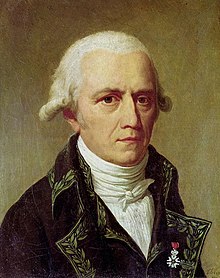Jean-Baptiste Lamarck | |
|---|---|
 Lamarck by Charles Thévenin, c. 1802 | |
| Born | 1 August 1744 |
| Died | 18 December 1829 (aged 85) Paris, France |
| Known for | Evolution; inheritance of acquired characteristics; Philosophie zoologique |
| Scientific career | |
| Fields | |
| Institutions | French Academy of Sciences; Muséum national d'Histoire naturelle; Jardin des Plantes |
| Author abbrev. (botany) | Lam. |
| Author abbrev. (zoology) | Lamarck |
| Part of a series on |
| Evolutionary biology |
|---|
 |
Jean-Baptiste Pierre Antoine de Monet, chevalier de Lamarck (1 August 1744 – 18 December 1829), often known simply as Lamarck (/ləˈmɑːrk/;[1] French: [ʒɑ̃batist lamaʁk][2]), was a French naturalist, biologist, academic, and soldier. He was an early proponent of the idea that biological evolution occurred and proceeded in accordance with natural laws.[3]
Lamarck fought in the Seven Years' War against Prussia, and was awarded a commission for bravery on the battlefield.[4] Posted to Monaco, Lamarck became interested in natural history and resolved to study medicine.[5] He retired from the army after being injured in 1766, and returned to his medical studies.[5] Lamarck developed a particular interest in botany, and later, after he published the three-volume work Flore françoise (1778), he gained membership of the French Academy of Sciences in 1779. Lamarck became involved in the Jardin des Plantes and was appointed to the Chair of Botany in 1788. When the French National Assembly founded the Muséum national d'Histoire naturelle in 1793, Lamarck became a professor of zoology.
In 1801, he published Système des animaux sans vertèbres, a major work on the classification of invertebrates, a term which he coined.[6] In an 1802 publication, he became one of the first to use the term "biology" in its modern sense.[7][Note 1] Lamarck continued his work as a premier authority on invertebrate zoology. He is remembered, at least in malacology, as a taxonomist of considerable stature.
The modern era generally remembers Lamarck for a theory of inheritance of acquired characteristics, called Lamarckism (inaccurately named after him), soft inheritance, or use/disuse theory,[8] which he described in his 1809 Philosophie zoologique. However, the idea of soft inheritance long antedates him, formed only a small element of his theory of evolution, and was in his time accepted by many natural historians. Lamarck's contribution to evolutionary theory consisted of the first truly cohesive theory of biological evolution,[9] in which an alchemical complexifying force drove organisms up a ladder of complexity, and a second environmental force adapted them to local environments through use and disuse of characteristics, differentiating them from other organisms.[10] Scientists have debated whether advances in the field of transgenerational epigenetics mean that Lamarck was to an extent correct, or not.[11]
- ^ "Lamarck". Random House Webster's Unabridged Dictionary.
- ^ Dudenredaktion, Kleiner & Knöbl (2015), pp. 484, 541.
- ^ "Jean-Baptiste Lamarck | Biography, Theory of Evolution & Facts". Encyclopaedia Britannica. 20 July 1998. Retrieved 2 April 2021.
- ^ Damkaer (2002), p. 117.
- ^ a b Packard (1901), p. 15.
- ^ "Jean-Baptiste Lamarck (1744-1829)". ucmp.berkeley.edu. Retrieved 1 October 2023.
- ^ Coleman (1977), pp. 1–2.
- ^ Jurmain et al. (2011), pp. 27–39.
- ^ Darwin (2001), p. 44.
- ^ Gould (2002), p. 187.
- ^ Haig (2007), pp. 415–428.
Cite error: There are <ref group=Note> tags on this page, but the references will not show without a {{reflist|group=Note}} template (see the help page).